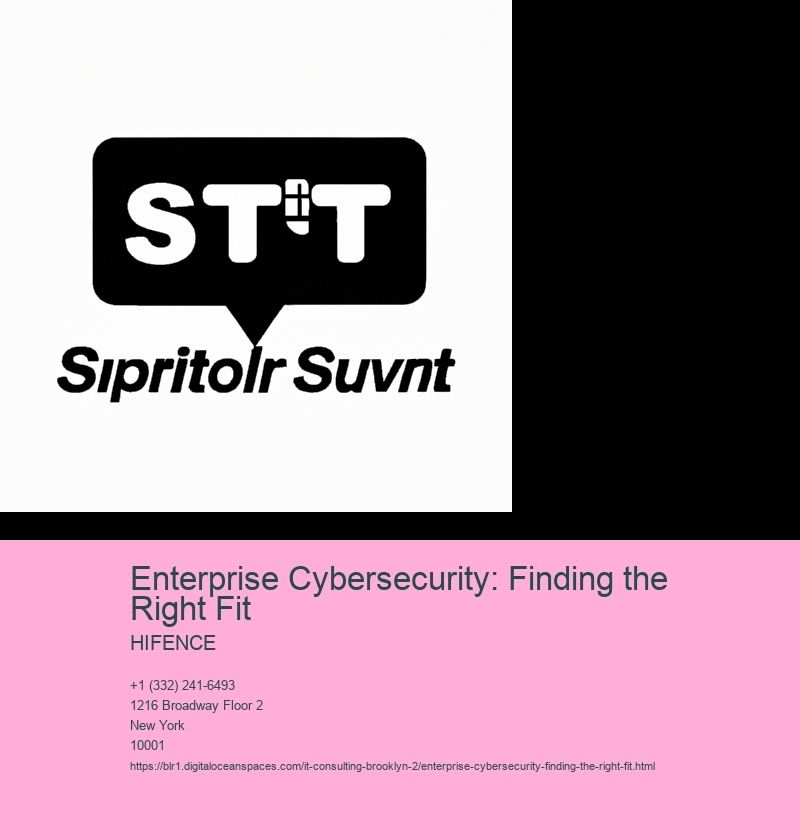Enterprise Cybersecurity: Finding the Right Fit
managed services new york city
Understanding Your Organizations Cybersecurity Needs
Okay, so, like, figuring out your cybersecurity needs for a big company can be, well, kinda a headache! AI vs. Your Enterprise: Cybersecurity Readiness? . Its not just about slapping on some antivirus and calling it a day, ya know? You gotta really understand what makes your org tick... and what makes it a target.
Think about it. Are you handling super sensitive customer data? Maybe youre dealing with intellectual property that competitors would kill for. Or, heck, maybe youre just a small shop but rely heavily on internet connectivity to, like, even function. All that stuff matters! It shapes the kinds of threats that are most likely to come your way.
Then theres the "right fit" part. You dont want to overspend on fancy security tools if all you really need is some basic employee training and a good firewall. But also, you dont want to cheap out and leave yourself wide open to ransomware. Finding that sweet spot means assessing your risks, weighing your options, and honestly, probably getting some expert advice. Its a lot, I know!
Its like, building a security strategy isnt one size fits all. Its more like tailoring a suit. You gotta get the measurements right, choose the right fabric (technology!), and make sure it actually fits your companys culture and way of doing things. It is so important.
Assessing Available Cybersecurity Solutions
Figuring out what cybersecurity solutions actually work for your enterprise is like trying to find the perfect pair of jeans. Theres a million different brands, each promising the world, and half of em just dont fit right, ya know?
First, you gotta know your own body, or in this case, your own business. managed services new york city What are your biggest security risks? Are you worried about phishing attacks, ransomware, or maybe internal threats? Knowing your weaknesses is, like, step one. Then, you gotta consider your budget. Aint nobody got endless money to throw at fancy security tools that they dont even need.
Then comes the hard part: actually looking at all the solutions! Theres firewalls, intrusion detection systems, endpoint protection, security information and event management (SIEM) tools... the list goes on and on. Reading reviews and talking to other companies in your industry can really help, but be careful of vendor hype! Theyre all gonna say theyre the best, but you gotta cut through the marketing fluff.

Dont just buy something because it sounds cool either. Make sure it integrates with your existing systems! You dont want a bunch of security tools that cant talk to each other – thats just a recipe for disaster. And for goodness sake, get a trial period! managed it security services provider Actually test the solution in your environment to see if it really does what it says it does.
Finding the right fit is a process, not a one-time purchase. Its an ongoing thing, and youll probably need to adjust your strategy as your business grows and the threat landscape changes. But hey, at least youll be more secure! It is worth it!
Key Considerations for Choosing the Right Solutions
Okay, so, picking the right cybersecurity stuff for your company? Its not exactly a walk in the park, is it? Its more like navigating a minefield blindfolded, except the mines are, you know, data breaches and ransomware!
First off, you gotta really, really understand what youre trying to protect. Like, whats your "crown jewels," right? Is it customer data? Secret formulas? The office coffee machines brew schedule? (Okay, maybe not that last one, but you get the point.) Knowing whats valuable helps you figured out where to put your security efforts.
And then theres the budget. Oh, the budget! Cybersecurity aint cheap, thats for sure. But you dont necessarily need the fanciest, most expensive gadgets on the market. Think about what you actually need, and what you can actually afford. Maybe start with the basics and build from there? A small bussiness probably doesnt need the same level of protection as, say, NASA.
Dont forget about your people! You could have the best security software ever, but if your employees are clicking on every suspicious link they see, then youre still in trouble. Train them! Make sure they know how to spot a phishing email and how to create a strong passwords. Its suprisingly important.

Also, think about how well the new security solution will play with your existing systems. Will it integrate seamlessly, or will it be a total headache to manage? Compatibility is key!
And finally, read reviews! Talk to other businesses in your industry. See what solutions theyre using and what they like (or dont like) about them. Getting real-world feedback can be way more helpful than just reading marketing materials. Its a jungle out there!
Implementing and Integrating Cybersecurity Measures
Enterprise cybersecurity! Its not just about buying the fanciest firewall or the latest antivirus software. Its about figuring out what actually works for your business, your specific risks, and how your people use tech every day. Implementing is one thing, like, slapping on a bandage.
Enterprise Cybersecurity: Finding the Right Fit - managed service new york
- managed services new york city
- managed services new york city
- managed services new york city
- managed services new york city
- managed services new york city
- managed services new york city
- managed services new york city
See, you can have all the best security tools, but if they dont talk to each other, or if your employees havent got a clue how to use them properly, its like having a super strong lock on a door but leaving the window wide open. Thats not very effective, is it?
Integration is key. Your threat intelligence needs to feed into your incident response plan, which needs to be understood by your IT team, and even your HR department! And its gotta be a custom fit. A small shop doesnt need the same level of protection as a huge corporation. The cost alone would be crazy expensive!
Finding the right fit means assessing your risks, understanding your business processes, and then choosing technologies that actually solve your problems, and that your staff can actually use without wanting to throw their computers out of the window. Its a ongoing process, not a one-time purchase. You gotta keep learning, keep adapting, and keep testing!

Monitoring, Maintenance, and Incident Response
Enterprise cybersecurity isnt just about building a fortress; its about keeping it running, patching the cracks, and reacting swiftly when someone inevitably tries to break in. Thats where monitoring, maintenance, and incident response come together, like a well oiled machine, to keep things safe. But finding the right balance, the "fit," for your specific enterprise is more art than science, honestly.
Think about monitoring. You cant protect what you cant see, right? So you need systems constantly watching for suspicious activity. This could be anything from weird login attempts, large data transfers, or even just unusual system behavior. Too much monitoring, though, and youre drowning in alerts, missing the real threats in the noise. Too little, and youre basically flying blind.
Then theres maintenance. Keeping software updated, patching vulnerabilities, and regularly auditing your security posture is crucial. Its like getting your car serviced; skip it, and youre asking for trouble down the road! But maintenance takes time and resources. Finding the right schedule and prioritizing the most critical systems is, again, a balancing act.
And finally, incident response. When, not if, a security incident occurs, you need a plan. A well defined process for identifying, containing, eradicating, and recovering from the attack is key. Do you have a dedicated team? Clear communication channels? Practice run through of different scenarios? A good incident response plan can minimize damage and get you back on your feet quickly. A bad one... well, lets just say it can be catastrophic!
Getting the right fit for your enterprise means assessing your specific risks, resources, and business needs. Theres no one-size-fits-all solution. You gotta tailor your approach to what makes sense for you. Its a constant process of evaluation and refinement. Its hard but its important!
Budgeting and Justifying Cybersecurity Investments
Budgeting and Justifying Cybersecurity Investments: Finding the Right Fit
Okay, so, Enterprise Cybersecurity, right? Its like, a really big deal! You gotta protect your stuff, or else… well, bad things happen. But heres the kicker: paying for it. Budgeting and justifying those cybersecurity investments? It's a whole other level of tricky.
First off, nobody really wants to spend money on something they dont see. Like, a firewall? Its just sitting there quietly, hopefully doing its job. It's not like shiny new software that actually shows off its features. So, you need to translate tech speak into business speak. Instead of saying "we need a next-gen intrusion detection system," try "this prevents data breaches that could cost us millions in fines and lost customer trust." check See? Much better.
And then theres the justification part. You cant just say "we need more security because cyber-attacks are up." Thats too vague. You need data. Actual numbers. Risk assessments. Show how the proposed investment reduces specific risks to acceptable levels. Maybe compare different solutions and highlight why yours is the best value, not just the cheapest. A cheap lock is not gonna stop a professional thief.
Also, dont forget about training! People are often the weakest link. No matter how fancy your tech is, someones gonna click on a dodgy link if they arent paying attention. So, budget for that too.
Its a constantly learning process, and its important to remember that you cant possibly protect from everything. Its about finding the right fit for your company, your risk tolerance, and your budget. Good luck, youll need it!
Future-Proofing Your Enterprise Cybersecurity Strategy
Okay, so, like, enterprise cybersecurity, right? Its not just about buying the fanciest firewall or whatever. Its about thinking ahead, future-proofing stuff, you know? You cant just slap on security measures and expect them to work forever because hackers, theyre always evolving. Always finding new ways in.
So, what does future-proofing even mean? Well, its about building a cybersecurity strategy that can adapt. Its about assuming that breaches will happen, not just might happen. Its about layers, like an onion. Not a tasty onion, but a security onion.
You gotta think about things like, um, employee training. Cause people are often the weakest link, accidentally clicking on dodgy links and stuff. And, you need to have a solid incident response plan. What happens when the inevitable happens? Who do you call? What systems do you shut down? You cant be making it up as you go along, thats a recipe for disaster!
Then theres the whole cloud thing. More and more companies are moving to the cloud, which is great, but it also introduces new risks. You gotta make sure your cloud security is up to snuff, and that your data is protected wherever it lives.
And, importantly, you gotta stay informed. What are the latest threats? What are the best practices?
Enterprise Cybersecurity: Finding the Right Fit - managed it security services provider
Its tough, but worth it!
